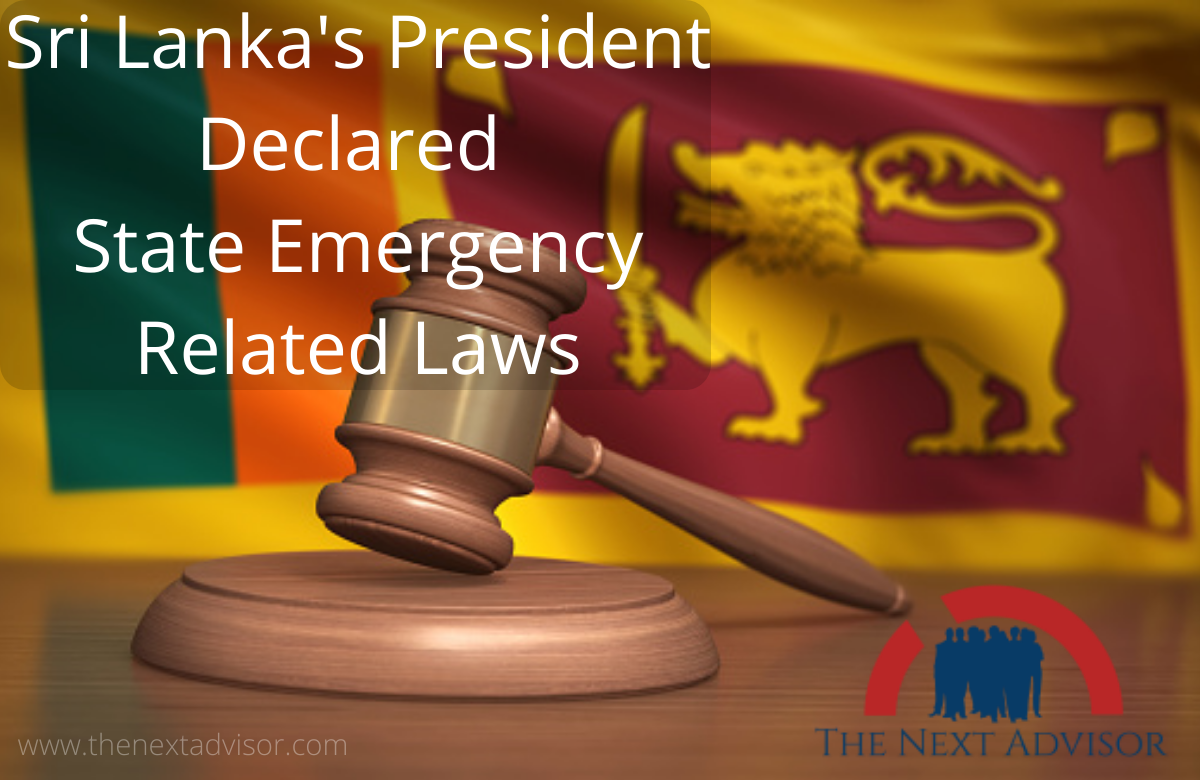Recently one breaking news is coming, Sri Lanka’s President declared a state of emergency amid protest. Let us see in detail why Mahinda Rajapaksa, Sri Lanka’s President declared a state of emergency.
WHAT HAS HAPPENED?
Sri Lanka’s president declared a state of emergency in the island nation Saturday, A day after angry protesters demonstrated near his home demanding he resign and as plans were made for a nationwide protest over the country’s worst economic crisis in memory.
President Gotabaya Rajapaksa invoked sections of the Public Security Ordinance, which gives him authority to make regulations, In the interests of public security, preservation of public order, suppression of mutiny, riot, or civil commotion, or for the maintenance of essential supplies.
Under the emergency regulations, the president can authorize detentions, take possession of any property, and search any premises. He can also change or suspend any law.
CONSTITUTION PROVISIONS
According to Article 155 of the Sri Lankan constitution, the President has the sole discretion to declare a state of emergency by way of proclamation and the declaration of the same cannot be challenged in courts. The proclamation issued by the President is valid for one month. The Parliament must approve it within 14 days. If not approved, the Proclamation will expire.
But Why did Sri Lanka’s President Declare an Emergency? ( Sri Lanka’s President Declared A State of Emergency )
The order came a day after dozens of people were arrested following protests near the president’s home. There are also calls for an island-wide public protest on Sunday. Rajapaksa’s office blamed ” organized extremists ” among the thousands of protesters for violence during Thursday night’s demonstration, Where police fired tear gas and a water cannon and arrested 54 people.
WHY PEOPLE ARE PROTESTING?
They blame Rajapaksa for long power outages and shortages of essential goods. Sri Lanka has huge debt obligations and dwindling foreign reserves, and its struggle to pay for imports has caused shortages. People wait in long lines for fuel, and power is cut for several hours daily because there’s not enough fuel to operate generating plants and dry weather has sapped hydropower capacity.
Sri Lanka’s economic woes are blamed on successive governments not diversifying exports and relying on cash sources like tea, garments, and tourism, and on a culture of consuming imported goods. The COVID – 19 pandemic dealt a heavy blow to Sri Lanka’s economy, with the government estimating a loss of $ 14 billion in the last two years.
Sri Lanka also has immense foreign debt after borrowing heavily on projects that don’t earn money. Its foreign debt repayment obligations are around $ 7 billion for this year alone. According to the Central Bank, inflation rose to 17.5 % in February from 16.8 % a month earlier. It is expected to continue rising because the government has allowed the local currency to float freely.
THE 4 BROTHERS (Responsible for Sri Lanka’s President Declared A State of Emergency)
The 4 brothers of the Rajapaksa Family are totally responsible for this situation. The names of these 4 Brothers are as follows:-
1. Gotabaya Rajapaksa- President of Sri Lanka.
2. Mahinda Rajapaksa- Prime Minister of Sri Lanka.
3. Basil Rajapaksa- Finance Minister.
4. Chamal Rajapaksa- Irrigation Minister.
The island nation of 22 million people is facing its worst economic upheaval in a decade. From an ill-fated fertilizer ban that led to a dramatic fall in yields of crops like rice and tea, to its failure to deal with a foreign-currency crisis that’s now a humanitarian emergency, The government of President Gotabaya Rajapaksa is fast running out of solutions. Relying until now on help from its two major backers—India and China and stubbornly refusing wider international aid, the country is on the verge of default.
Gotabaya, who won office in the November 2019 presidential elections, appointed his brother, Mahinda, as Prime Minister. Mahinda first came to power in 2004, initially as Prime Minister and then as President. At the time, Gotabaya was defense secretary and was notorious for his role in the 2009 operation to end the civil war with Tamil rebels. The Rajapaksas were out of power briefly from 2015, when Maithripala Sirisena and Ranil Wickremesinghe led the Country.
But all the Rajapaksas in power haven’t been able to do what needed to be done to help Sri Lanka out of this mess. Things are bad enough that the brothers’ resistance to seeking support from the International Monetary Fund is softening. It all began with the government’s capital market borrowing back in 2007. ( Mahinda was president then. ) That now accounts for 38 % of the country’s foreign debt, while loans from China accounted for 10 %.
Given the severity of Sri Lanka’s plight, the initial reliance on government-to-government deals to finance the foreign exchange gap hasn’t been sufficient. Approaching the IMF is now the best option, complemented by efforts to access financing from India and China. Sri Lanka has asked both Beijing and New Delhi to consider restructuring its debt repayments after India in January extended a $400 million swap line and deferred an Asian Clearing Union settlement of $500 million.
China’s DEBT TRAP
The country is also seeking to negotiate a new loan with China. The Hambantota port – part of China’s Belt and Road Initiative – is widely viewed as an example of what can go wrong with Beijing’s infrastructure drive. Sri Lanka borrowed heavily to build the port, couldn’t repay the loans, and then gave China a 99 – year lease for debt relief.



























